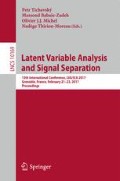Abstract
In this paper we introduce a low-latency monaural source separation framework using a Convolutional Neural Network (CNN). We use a CNN to estimate time-frequency soft masks which are applied for source separation. We evaluate the performance of the neural network on a database comprising of musical mixtures of three instruments: voice, drums, bass as well as other instruments which vary from song to song. The proposed architecture is compared to a Multilayer Perceptron (MLP), achieving on-par results and a significant improvement in processing time. The algorithm was submitted to source separation evaluation campaigns to test efficiency, and achieved competitive results.
Access this chapter
Tax calculation will be finalised at checkout
Purchases are for personal use only
Notes
- 1.
References
Abdel-Hamid, O., Mohamed, A.R., Jiang, H., Deng, L., Penn, G., Yu, D.: Convolutional neural networks for speech recognition. IEEE/ACM Trans. Audio Speech Lang. Process. 22(10), 1533–1545 (2014)
Chandna, P.: Audio source separation using deep neural networks, Master Thesis, Universitat Pompeu Fabra (2016)
Dong, C., Loy, C.C., He, K., Tang, X.: Image super-resolution using deep convolutional networks. CoRR, abs/1501.00092 (2015)
Durrieu, J., Ozerov, A., Févotte, C.: Main instrument separation from stereophonic audio signals using a source/filter model. In: 17th European Signal Processing Conference (2009)
Gómez, E., Cañadas, F., Salamon, J., Bonada, J., Vera, P., Cabañas, P.: Predominant fundamental frequency estimation vs singing voice separation for the automatic transcription of accompanied flamenco singing. In: 13th International Society for Music Information Retrieval Conference (ISMIR 2012) (2012)
Han, Y., Lee, K.: Acoustic scene classification using convolutional neural network and multiple-width frequency-delta data augmentation (2016)
Hidalgo, J.: Low latency audio source separation for speech enhancement in cochlear implants, Master Thesis, Universitat Pompeu Fabra (2012)
Huang, P.-S., Kim, M., Hasegawa-Johnson, M., Smaragdis, P.: Deep learning for monaural speech separation. In: Acoustics, Speech and Signal Processing (ICASSP), pp. 1562–1566 (2014)
Kokkinakis, K., Loizou, P.C.: Using blind source separation techniques to improve speech recognition in bilateral cochlear implant patients. J. Acoust. Soc. Am. 123(4), 2379–2390 (2008)
Krizhevsky, A., Sutskever, I., Hinton, G.E.: ImageNet classification with deep convolutional neural networks. In: Advances in Neural Information Processing Systems, pp. 1097–1105 (2012)
Noh, H., Hong, S., Han, B.: Learning deconvolution network for semantic segmentation. CoRR, abs/1505.04366 (2015)
Nugraha, A.A., Liutkus, A., Vincent, E.: Multichannel audio source separation with deep neural networks. Technical report (2016)
Rafii, Z., Liutkus, A., Pardo, B.: REPET for background/foreground separation in audio. In: Naik, G.R., Wang, W. (eds.) Blind Source Separation, pp. 395–411. Springer, Heidelberg (2014)
Sainath, T.N., Kingsbury, B., Ramabhadran, B.: Auto-encoder bottleneck features using deep belief networks. In: 2012 IEEE International Conference on Acoustics, Speech and Signal Processing (ICASSP), pp. 4153–4156. IEEE (2012)
Simpson, A.J.R.: Probabilistic Binary-Mask Cocktail-Party Source Separation in a Convolutional Deep Neural Network (2015)
Uhlich, S., Giron, F., Mitsufuji, Y.: Deep neural network based instrument extraction from music. In: 2015 IEEE International Conference on Acoustics, Speech and Signal Processing (ICASSP), pp. 2135–2139. IEEE (2015)
Vincent, E., Gribonval, R., Fevotte, C.: Performance measurement in blind audio source separation. IEEE Trans. Audio Speech Lang. Process. 14(4), 1462–1469 (2006)
Wang, Y., Narayanan, A., Wang, D.: On training targets for supervised speech separation. IEEE/ACM Trans. Audio Speech Lang. Process. 22(12), 1849–1858 (2014)
Zeiler, M.D.: Adadelta: an adaptive learning rate method. arXiv preprint arXiv:1212.5701
Acknowledgments
The TITANX used for this research was donated by the NVIDIA Corporation. This work is partially supported by the Spanish Ministry of Economy and Competitiveness under CASAS project (TIN2015-70816-R).
Author information
Authors and Affiliations
Corresponding author
Editor information
Editors and Affiliations
Rights and permissions
Copyright information
© 2017 Springer International Publishing AG
About this paper
Cite this paper
Chandna, P., Miron, M., Janer, J., Gómez, E. (2017). Monoaural Audio Source Separation Using Deep Convolutional Neural Networks. In: Tichavský, P., Babaie-Zadeh, M., Michel, O., Thirion-Moreau, N. (eds) Latent Variable Analysis and Signal Separation. LVA/ICA 2017. Lecture Notes in Computer Science(), vol 10169. Springer, Cham. https://doi.org/10.1007/978-3-319-53547-0_25
Download citation
DOI: https://doi.org/10.1007/978-3-319-53547-0_25
Published:
Publisher Name: Springer, Cham
Print ISBN: 978-3-319-53546-3
Online ISBN: 978-3-319-53547-0
eBook Packages: Computer ScienceComputer Science (R0)

